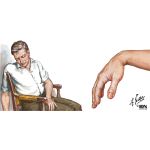Saturday Night Palsy
There are a number of terms used to describe radial nerve injuries, which are usually dependent on the causation factor:
Saturday night palsy from falling asleep with one's arm hanging over the arm rest of a chair, compressing the radial nerve at the spiral groove.
Honeymoon palsy from another individual sleeping on and compressing one's arm overnight.
Crutch palsy from poorly fitted axillary crutches.
Squash palsy, from traction forces in a manner usually associated with the sport squash, can happen to squash players during prolonged periods between matches.in
The palsy makes the extensors of the wrist joint weak or paralysed usually temporarily. The wrist cannot be lifted up against gravity when the forearm is pronated. See the pic on the right side.
It is splinted to protect the extensors of the wrist from getting stretched and electrical stimulation is given to keep the muscle from atrophying and later on extension exercises for the wrist is given - in a graded fashion and later on weighted exercises are given to strengthen the extensors.
Coronary Sinus
The coronary sinus is a collection of veins joined together to form a large vessel that collects blood from the heart muscle (myocardium). It delivers deoxygenated blood to the right atrium,
Olfactory receptors in the nose
In the new study, the researchers say they suspected the human nose could smell many more than 10,000 scents, based on the fact that a typical nose has 400 olfactory receptors. The human eye has only three color receptors, and yet people can see up to 10 million colors, the researchers noted.
Primary lymphatic organs are where lymphocytes are formed and mature. They provide an environment for stem cells to divide and mature into B- and T- cells: There are two primary lymphatic organs: the red bone marrow and the thymus gland.
Secondary or peripheral lymphoid organs, which include lymph nodes and the spleen, maintain mature naive lymphocytes and initiate an adaptive immune response. The peripheral lymphoid organs are the sites of lymphocyte activation by antigens. Activation leads to clonal expansion and affinity maturation.
The termination of the spinal cord
The terminal portion of the spinal cord is called the conus medullaris.
The pia mater continues as an extension called the filum terminale, which anchors the spinal cord to the coccyx. The cauda equina ("horse's tail") is the name for the collection of nerves in the vertebral column that continue to travel through the vertebral column below the conus medullaris. The cauda equina forms as a result of the fact that the spinal cord stops growing in length at about age four, even though the vertebral column continues to lengthen until adulthood. This results in the fact that sacral spinal nerves actually originate in the upper lumbar region.
Trachea - hyaline cartilage rings
A ring of hyaline cartilage called the cricoid cartilage forms the inferior wall of the larynx and is attached to the top of the trachea. The cricoid cartilage is the only complete ring of cartilage in the trachea. Below this there are from fifteen to twenty incomplete C-shaped tracheal rings or tracheal cartilages, also of hyaline, that reinforce the front and sides of the trachea to protect and maintain the airway. This leaves a membranous wall at the back, (about a third of the ring's diameter) without cartilage. T
Oligospermia
Sperm concentrations fluctuate and oligospermia may be temporary or permanent.
Sources usually classify oligospermia in 3 classes:[4]
Mild: concentrations 10 million – 20 million sperm/mL
Moderate: concentrations 5 million – 10 million sperm/mL
Severe: concentrations less than 5 million sperm/mL
The diagnosis of oligozoospermia requires a work-up via semen analysis
Breast support
Female breast ptosis or sagging is a natural consequence of aging. The rate at which a woman's breasts droop and the degree of ptosis depends on many factors. The key factors influencing breast ptosis over a woman's lifetime are cigarette smoking, her number of pregnancies, gravity, higher body mass index, larger bra cup size, and significant weight gain and loss. Post-menopausal women may experience increased ptosis due to a loss of skin elasticity. Many women and medical professionals mistakenly believe that breastfeeding increases sagging. It is also commonly believed that the breast itself offers insufficient support and that wearing a bra prevents sagging which has not been found to be true.
Plastic surgeons categorize the severity of ptosis by evaluating the position of the nipple relative to the infra-mammary fold, the point at which the underside of the breasts attach to the chest wall. In the most advanced stage, the nipples are below the fold and point towards the ground.
Myelination
In the central nervous system (CNS) — the brain and spinal cord — cells called oligodendrocytes wrap their branch-like extensions around axons to create a myelin sheath. In the nerves outside of the spinal cord, Schwann cells produce myelin.Mar 24, 2015
Sartorius muscle
The sartorius muscle is the longest muscle in the human body. It is a long, thin, superficial muscle that runs down the length of the thigh in the anterior compartment. Its upper portion forms the lateral border of the femoral triangle.
The sartorius muscle is the longest muscle in the body and arises by tendinous fibres from the anterior superior iliac spine, running obliquely across the upper and anterior part of the thigh in an inferomedial direction.
It descends as far as the medial side of the knee, passing behind the medial condyle of the femur to end in a tendon.
This tendon curves anteriorly to join the tendons of the gracilis and semitendinosus muscles which together form the pes anserinus, finally inserting into the proximal part of the tibia on the medial surface of its body.
Nerve supply
Situated in the anterior fascial compartment of the thigh, the sartorius is innervated via the anterior (or superficial) branch of the femoral nerve . The femoral nerve is responsible for both sensory and motor components in the sartorius and provides proprioceptive feedback for the muscle



